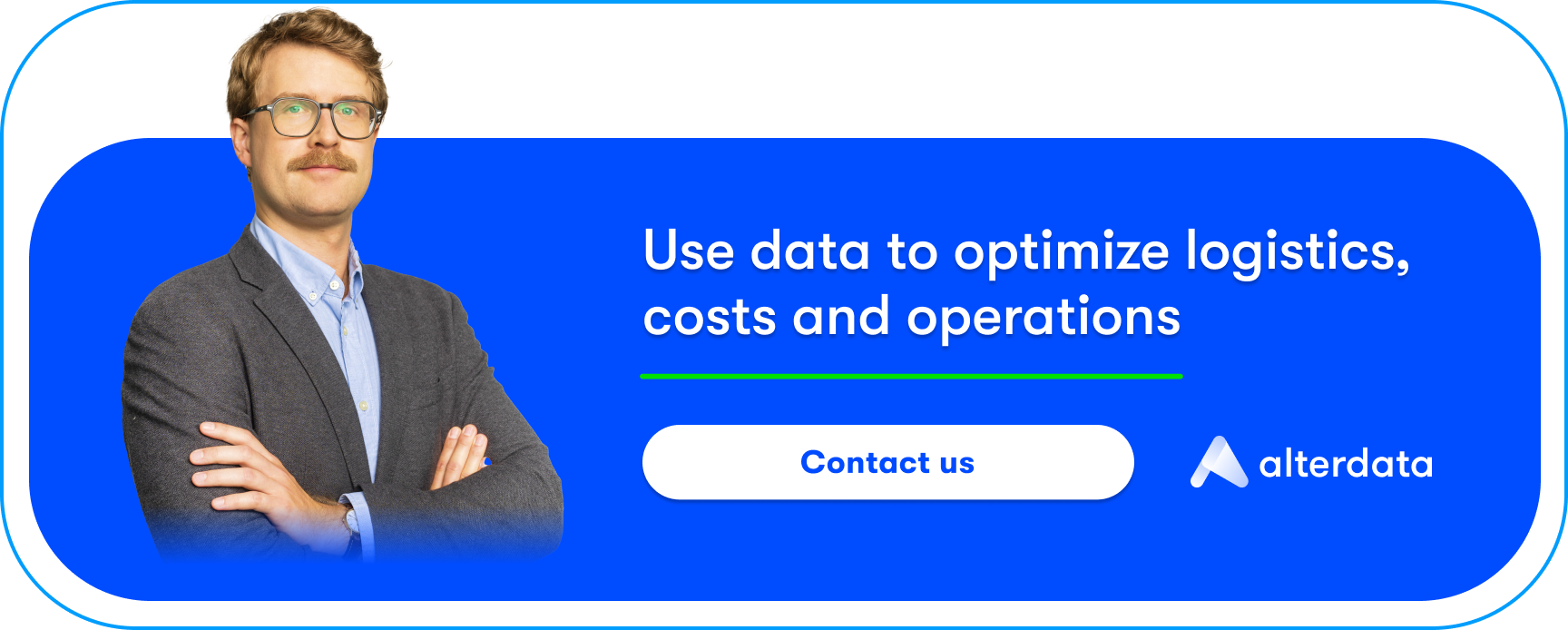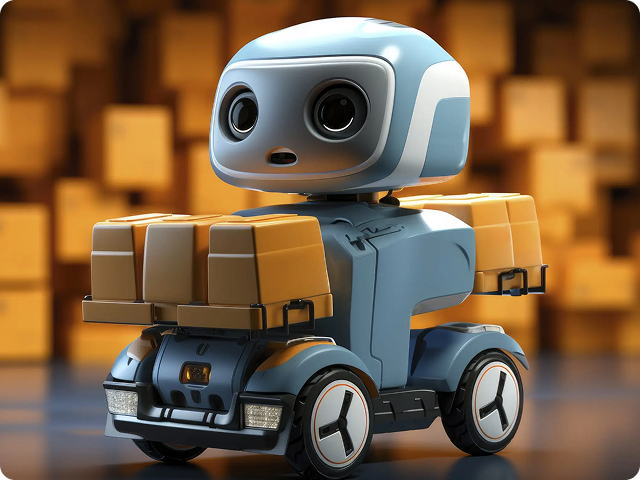Introduction
In logistics, there is no room for chance. When a product must reach the customer in perfect condition, shipped internationally, in custom packaging, and through three different carriers, every decision counts. And there are more and more of them: the type of transport, its availability, cost, risk of delay or damage. Effective route planning and logistics operations require analyzing large amounts of data, which is crucial for making accurate decisions in a dynamically changing logistics environment. With AI, companies can analyze vast amounts of information to improve logistics decision-making and optimize every step of the supply chain. How not to get lost in this chaos?
More and more companies are choosing prediction, data-driven decisions, and AI models. A well-designed machine learning system can predict which packages are most at risk of damage and suggest the best shipping method. Demand prediction is also a key application, allowing businesses to forecast needs more accurately and plan resources accordingly. AI is enhancing efficiency in logistics operations by automating processes, improving demand forecasting, and optimizing workflows. This is not science fiction. It is already working.
However, implementing AI in logistics comes with challenges such as ensuring security, high data quality, and integrating new technologies with existing systems. Overcoming these barriers is key to fully harnessing the potential of artificial intelligence in the industry. AI also helps streamline operations in logistics by reducing waiting times and improving overall supply chain performance.

Intuition is no longer enough
Until recently, many companies made logistics decisions based on team experience and general guidelines. If a piece of furniture is large, it goes by dedicated transport. If a package is to go to Germany, we choose company X because “they usually don’t fail.”
But in a data-driven logistics world, “usually” is not enough.
Variables such as:
- package size and quantity,
- product material,
- destination country,
- local carrier,
- history of claims in a given region
…can (and should) be calculated. AI supports demand and order forecasting, and its advanced forecasting capabilities significantly improve planning accuracy in warehouse management and supply chain operations. AI can detect patterns that humans might miss and analyze data to uncover insights that would otherwise go unnoticed, indicating the decision with the highest probability of success.
How does demand forecasting and logistics prediction based on Artificial Intelligence work?
This is not a magical black box. Every predictive project in logistics is based on specific historical data. Predictive models learn from historical data and make logistics decisions based on it.
Key steps:
- Data collection: from CRM, ERP systems, delivery tracking, claim history.
- Cleaning and preparation: normalization, error exclusion, feature engineering.
- Model training: on labeled data – e.g., whether a shipment arrived intact or damaged. Neural networks are often used for analyzing historical data, especially time series.
- Integration with the process: the model provides recommendations (e.g., “dedicated transport” for a specific order) in the operator’s panel. AI enables logistics automation by streamlining supply chain processes, improving efficiency, and reducing manual intervention. These recommendations support logistics management by optimizing transportation, storage, and delivery through data integration and AI-driven insights. Based on these, AI systems can dynamically optimize transport routes using techniques like reinforcement learning.
This approach not only increases decision accuracy but also reduces the cost of errors: claims, returns, transport reorganization, loss of customer trust. AI in logistics empowers data driven decision making, providing better insights and supporting long-term supply chain resilience.
Data security and quality – the foundation of effective prediction
Using artificial intelligence in logistics is based on one undeniable foundation: data. Logistics centers generate huge amounts of information every day – from barcode scans, warehouse management system data, to detailed transport reports. However, quantity alone is not enough. The quality of this data and its security are crucial.
Machine learning algorithms need complete, consistent, and up-to-date data to effectively predict behaviors and trends in the logistics industry. Thanks to AI, it is possible to analyze this data in real time, enabling quick responses to changing market conditions and optimizing logistics processes. For example, AI systems can immediately detect irregularities in the supply chain or predict potential delays before they become real problems.
But security must not be forgotten. Warehouse and transport logistics operate on sensitive information – from contractor data, customer data, order details, to transport routes. Implementing AI in logistics therefore requires not only attention to data quality but also protection against unauthorized access or loss. Appropriate security measures and policies become an integral part of every AI project.
By combining high-quality data, its security, and advanced machine learning algorithms, companies can achieve real cost reductions, increase logistics process efficiency, and gain a competitive advantage in the rapidly changing logistics industry environment. AI also significantly improves inventory tracking by analyzing real-time data, allowing for automated monitoring of inventory levels and more accurate demand prediction.

Integrating AI with existing logistics systems
Implementing artificial intelligence in logistics is not just about purchasing new software – it is an integration process that requires adapting existing systems and processes to new technological capabilities. A key to success is smoothly connecting AI with already functioning tools for warehouse, transport, and order management.
Thanks to AI, companies can optimize delivery routes in real time, forecast product demand, and manage inventory with unprecedented precision. AI-driven logistics route optimization, optimizing routes, and optimizing transportation routes enable businesses to analyze traffic, weather, and delivery constraints to determine the most efficient routes for transportation and delivery. Machine learning and deep learning allow analyzing market trends, predicting seasonal fluctuations, and automatically adjusting logistics strategies to current needs. Examples include autonomous vehicles or advanced fleet management systems, which are already changing the future of logistics today.
Using neural networks and other machine learning algorithms enables optimization of the entire supply chain – from order picking, through route planning, to real-time delivery monitoring. This not only increases logistics process efficiency but also allows faster reactions to changing market conditions and customer expectations.
Integrating AI and automation also involves robotic process automation, which streamlines and automates labor-intensive logistics processes and back-office tasks, further enhancing operational efficiency.
However, implementing AI in logistics is also a challenge. It requires not only investment in new technologies but, above all, adapting existing systems and processes to cooperate with AI. Support from an experienced partner who can guide the company through the entire process – from needs analysis, through integration, to optimization and AI solution development – is crucial.
The future of logistics belongs to those who can combine the potential of artificial intelligence with practical experience and proven systems. This approach allows gaining a competitive edge and staying at the forefront of the logistics industry.
It works. Our implementations confirm it
In a furniture company operating in a direct-to-consumer model across Europe, we implemented a predictive model supporting logistics decisions. The company’s products are individually designed by customers, and using AI allows better order management and optimizing product placement in the warehouse, which translates into more efficient warehouse logistics and inventory management. These improvements extended beyond logistics processes to enhance overall supply chain operations, including inventory control and compliance.
The model, based on data from thousands of shipments, indicated the probability of damage under different transport scenarios. Additionally, products were analyzed for damage risk, and the AI system supported order and goods management at every stage of the logistics process by helping analyze data and automate decision-making. The effect? Logistics teams gained concrete suggestions – not just “what usually works,” but what will work in this specific case.
The results included:
- reduced number of damages,
- more conscious use of dedicated transport,
- elimination of carriers with too high risk.

What do you need to start with AI in warehouse management and logistics?
Not every project has to start on a large scale. But a few things are essential:
- Data – preferably from multiple sources: ERP, orders, transport, claims. AI systems can analyze data from these sources to enable logistics automation, streamlining processes and improving efficiency.
- Domain knowledge – someone who knows which variables really matter.
- Team or partner – not every IT team has to know everything. Sometimes it’s better to focus on integration rather than building models from scratch. Modern AI systems allow easy adaptation of solutions to specific business needs, which significantly facilitates implementation in the logistics industry.
Process openness – AI can change the way decisions are made. You have to be ready to accept that. Implementing AI is key to maintaining competitiveness in the logistics market.
Conclusions: Predict before you fix
AI in logistics does not eliminate all problems. But it allows making better decisions, faster. Minimizing costs that until now were “included in the risk.” Artificial intelligence will play a key role in the future of the logistics industry – companies that can effectively harness its potential will gain a market advantage. As AI adoption grows, dynamic pricing and advanced forecasting capabilities will become increasingly important, enabling real-time price adjustments and more accurate demand prediction. In the long term, AI empowers data-driven decision making, leading to greater efficiency and supply chain resilience.
Sometimes just one well-predicted package less in claims makes it all worthwhile.
Natural language processing is also emerging as a valuable tool for improving communication, understanding multilingual data, and increasing efficiency in logistics operations.
Want to learn how such models could work in your company? See how we help operations teams connect data with decisions - contact us.




























